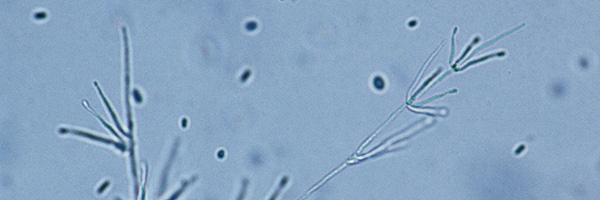
Verticillium dahliae Kleb., (1913)
Verticillium white-black Reinke & Berthold, (1879)
Verticillium wilt
- Classification: Fungi, Basidiomycota, Lichinomycetes, Hypocreomycetidae, Incertae_sedis_, Plectosphaerellaceae
- téléomorphe : Plectosphaerellaceae
- English name: Verticillium wilt
At least two species of Verticillium are likely to attack Cucurbitaceae.
Verticillium dahliae , a highly polyphagous fungus , affects several hundred herbaceous and woody host plants.
it has been reported on many Cucurbitaceae (cucumber, zucchini and squash, pumpkin, watermelon, etc.) in many producing countries in temperate and subtropical zones, especially on crops in open fields, sometimes under shelter, it is infrequently above ground:
For example, it is rife on melon in Romania, Tunisia, Turkey, Jordan and other Mediterranean regions, Europe, USA ...
Note that V. dahliae attacks melon crops in France, especially in the south . Its symptoms should not be confused with those of Fusarium wilt. This species has several vegetative compatibility groups (VCG), a limited number of them have been demonstrated on Cucurbitaceae. In addition, its pathogenicity appears to vary depending on the strain studied, its original host and its compatibility group. Certain strains present a certain parasitic specificity.
Another more confidential species, V. albo-atrum , is also reported in particular on apricot and cucumber in Iran and California. It has a wide geographical distribution but is mainly observed in temperate regions. Unlike the previous species, it does not form microsclerotia and its thermal optimum is lower. V. albo-atrum , genetically different from V. dahliae , is divided into 2 different groups; group A1 containing a PG1 pathotype (isolated from cucumber) and group A2.





